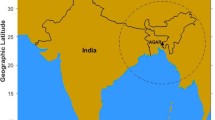Abstract
In recent years with the advancement in satellite based navigational applications, study of Total Electron Content (TEC) has gained significant importance. It is well known that due to dynamical behaviour of equatorial and low latitude ionosphere, the levels of ionization is relatively high herein. The sustained decrease in solar extreme ultraviolet radiations during the current minimum is greater than any in recent history. This gives us the opportunity to study the observations of global positioning system total electron content (GPS-TEC) dual frequency signals from the GPS satellites continuously recorded at Trivandrum (an equatorial station) and Delhi (a low latitude station) during the extremely low solar activity period from January 2007 to June 2009. This study illustrates the diurnal, seasonal and annual variations of TEC during the extended solar minimum period. This study also investigates the behaviour of daytime ionosphere around spring and autumn equinoxes at low solar activity period. The results clearly reveal the presence of equinoctial asymmetry which is more pronounced at equatorial station Trivandrum. The diurnal variation of TEC shows a short-lived day minimum which occurs between 0500 to 0600 LT at both the stations. Delhi TEC values show its steep increase and reach at its peak value between 1200 and 1400 LT, while at the equator the peak is broad and occurs around 1600 LT. Further, the daily maximum TEC ranges from about 5 to 40 TEC units at Trivandrum and about 10 to 40 TEC units at Delhi, which correspond to range delay variations of about 1 to 8 m at the GPS L1 frequency of 1.575 GHz. The Maximum values of TEC were observed during spring equinox rather than autumn equinox, showing presence of semi annual variation at both the locations. The minimum values of TEC were observed during the summer solstice at Trivandrum indicating the presence of winter anomaly at equatorial region while Delhi TEC values were minimum during winter solstice showing absence of winter anomaly. Also the TEC values at both the locations have been decreasing since 2007 onwards exhibit good positive correlation with solar activity.








Similar content being viewed by others
References
Bagiya, M.S., Joshi, H.P., Iyer, K.N., Aggarwal, M., Ravindran, S., Pathan, B.M.: TEC variations during low solar activity period (2005–2007) near the equatorial ionospheric anomaly crest region in India. Ann. Geophys. 27, 1047–1057 (2009)
Dabas, R.S., Bhuyan, P.K., Tyagi, T.R., Bhardwaj, R.K., Lal, J.B.: Day-to-day changes in ionospheric electron content at low latitudes. Radio Sci. 19, 749–756 (1984)
Dabas, R.S., Lakshmi, D.R., Reddy, B.M.: Solar activity dependence of ionospheric electron content and slab thickness using different solar indices. PAGEOPH 140(4) (1993)
Dasgupta, A., Basu, A.: Investigation of ionospheric electron content in the equatorial region as obtained by orbiting beacon satellites. Ann. Geophys. 29, 409–419 (1973)
Davies, K.: Recent progress in satellite radio beacon studies with particular emphasis on the ATS-6 radio beacon experiment. Space Sci. Rev. 25, 357–430 (1980)
Kane, R.P.: Irregular variations in the global distribution of total electron content. Radio Sci. 15, 837–842 (1980)
Langley, R., Fedrizzi, M., Paula, E., Santos, M., Komjathy, A.: Mapping the low latitude ionosphere with GPS. GPS World 13(2), 41–46 (2002)
Liu, L., Wan, W., Ning, B., Zhang, M.L.: Climatology of the mean total electron content derived from GPS global ionospheric maps. J. Geophys. Res. 114, A06308 (2009). doi:10.1029/2009JA014244
Mannucci, A.J., Wilson, B.D., Edwards, C.D.: A new method for monitoring the earth’s ionospheric total electron content using the GPS global network. In: Proc. of ION GPS-93, Inst. of Navigation, pp. 1323–1332 (1993)
Mendillo, M., Lynch, F.X., Klobuchar, J.A.: In: Donneylly, R.F. (ed.) Solar Terrestrial Predictions, vol. 4, pp. C1–C14. Space Environment Lab, Boulder (1980)
Modi, R.P., Iyer, K.N.: IEC and slab thickness near the peak. Indian J. Radio Space Phys. 18, 23–26 (1989)
Rama Rao, P.V.S., Srirama Rao, M., Satyam, M.: Diurnal and seasonal trends in TEC values observed at Waltair. Indian J. Radio Space Phys. 6, 233–235 (1977)
Rama Rao, P.V.S., Nru, D., Srirama Rao, M.: In: Wernik, A.W. (ed.) Proc. COSPAR/URSI Symp., Warsaw, Poland, p. 51 (1980)
Rama Rao, P.V.S., Niranjan, K., Ramana Rao, B.V., Rao, B.V.P.S., Prasad, D.S.V.V.D.: In: Proc. URSI/IPS Conference on the Ionosphere and Radiowave Propagation, Sydney, Australia (1985)
Rama Rao, P.V.S., Gopi Krishna, S., Niranjan, K., Prasad, D.S.V.V.D.: Temporal and spatial variations in TEC using simultaneous measurements from the Indian GPS network of receivers during the low solar activity period of 2004–2005. Ann. Geophys. 24, 3279–3292 (2006)
Rastogi, R.G., Sharma, R.P.: Ionospheric electron content at Ahmadabad (near the crest of equatorial anomaly) by using beacon satellite transmissions during half a solar cycle. Planet. Space Sci. 19, 1505–1517 (1971)
Rastogi, R.G., Iyer, K.N., Bhattacharya, J.C.: Total electron content of the ionosphere over the magnetic equator. Curr. Sci. 44, 531–533 (1975)
Van Dierendonck, A.J., Fenton, P., Klobuchar, J.: Commercial ionospheric scintillation monitoring receiver development and test results. In: Proceedings of the Institute of Navigation’s 52nd Annual Technical Meeting, Cambridge, MA, pp. 573–582 (1996)
Acknowledgements
We are thankful to World Data Center for Geomagnetism, Kyoto, for providing us the Dst and Ap values. One of the authors (Dr. Kavita Sharma) would like to thank Prof. Rakesh Kumar, Head, Department of Physics, C.C.S. University Meerut, U.P. INDIA for providing the necessary facilities to complete this research paper.
Author information
Authors and Affiliations
Corresponding author
Rights and permissions
About this article
Cite this article
Sharma, K., Dabas, R.S. & Ravindran, S. Study of total electron content variations over equatorial and low latitude ionosphere during extreme solar minimum. Astrophys Space Sci 341, 277–286 (2012). https://doi.org/10.1007/s10509-012-1133-3
Received:
Accepted:
Published:
Issue Date:
DOI: https://doi.org/10.1007/s10509-012-1133-3




